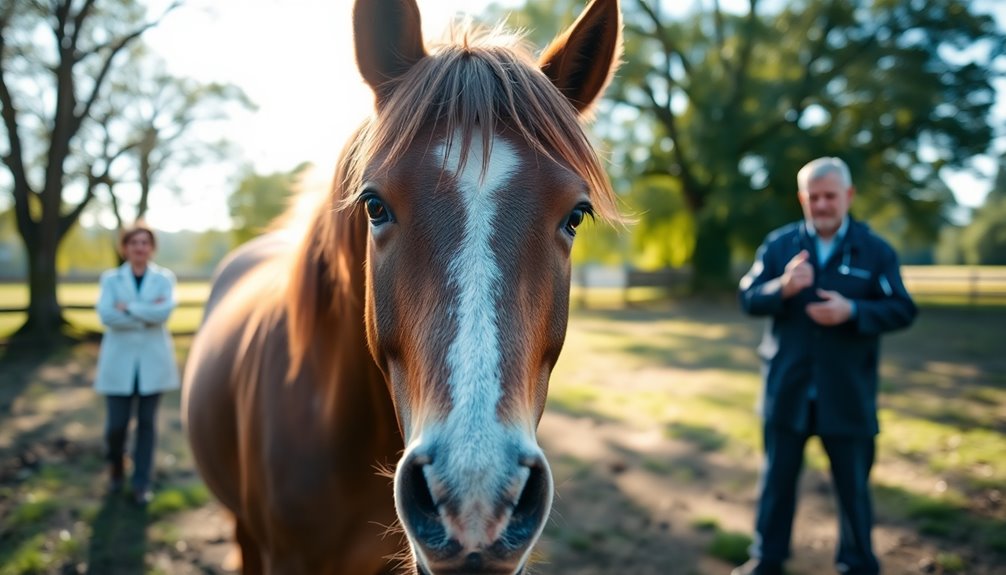Stereotypies are repetitive, purposeless movements you might notice in yourself or others. They often appear in early childhood and can include behaviors like body rocking, hand flapping, or nail biting. Experts find them mysterious because they can arise from various causes, including genetic factors, environmental stressors, and developmental disorders. While some types are benign, others can impact social interactions and daily life. Understanding these behaviors is essential for effective management, often through behavioral therapies. If you're curious to learn more about their complexities and treatment options, you won't want to miss the next insights on this fascinating topic!
Key Takeaways
- Stereotypies are repetitive, purposeless movements seen in both humans and animals, often including behaviors like thumb sucking and body rocking.
- They typically arise in early childhood, often before age three, and can persist into later developmental stages.
- The DSM-5 classifies stereotypies into primary (idiopathic) and secondary (associated with developmental disorders) types, each requiring different diagnostic approaches.
- Genetic factors, environmental influences, and neurobiological mechanisms contribute to the onset and persistence of stereotypies, complicating their understanding.
- Effective management involves early behavioral interventions and family involvement, but further research is needed to refine treatment protocols and diagnostic criteria.
Definition of Stereotypies

Stereotypies refer to repetitive, purposeless movements or behaviors that you might observe in both humans and animals. These behaviors often manifest as motor movements, such as thumb sucking, nail biting, or body rocking.
In children, stereotypies can start before age three and may persist into later childhood. While some children exhibit primary motor stereotypies, which occur in typically developing kids, others might display secondary motor stereotypies associated with developmental disorders like autism and intellectual disabilities.
You might notice that these repetitive behaviors often become more pronounced during times of stress or anxiety, interfering with social interactions, academic performance, or daily activities.
The DSM-5 recognizes these stereotypic movements as self-driven motor behaviors that seem purposeless. It's vital to understand that while all children might engage in some stereotypies, those linked to developmental disorders may require further evaluation and support.
Recognizing these patterns early can lead to better management strategies and enhance the child's quality of life. So, if you observe these behaviors in a child, it's important to pay attention and seek guidance if necessary.
Classification of Stereotypies

Understanding the classification of stereotypies is vital for recognizing their impact on individuals. Stereotypies are primarily categorized into two types: primary motor stereotypies and secondary motor stereotypies. Each classification has unique characteristics and implications for diagnosis and intervention strategies.
- Primary Motor Stereotypies: These occur in typically developing children and are characterized by repetitive behaviors that seem purposeless.
- Secondary Motor Stereotypies: These are associated with developmental conditions such as autism and intellectual disabilities. They often manifest alongside other behavioral findings and indicate underlying neurological issues.
- Diagnostic Criteria: The DSM-5 views stereotypic movements as self-driven motor behaviors that can interfere with daily activities and social interactions. Accurate diagnosis is essential to distinguish them from other movement disorders.
- Severity Levels: Classification also considers the presence of self-injurious behaviors and ranges from mild to severe, greatly impacting the individual's quality of life.
Common Types of Stereotypies

When you think about common types of stereotypies, primary motor stereotypies often come to mind, like thumb sucking and body rocking. These behaviors are typical in young children and can provide comfort in stressful situations.
On the other hand, secondary motor stereotypies involve more complex movements and can include additional behaviors, highlighting the variety within these repetitive actions.
Primary Motor Stereotypies
Repetitive movements in children often take the form of primary motor stereotypies, which can include body rocking, head nodding, or hand flapping. These behaviors are common in typically developing children and usually emerge in early childhood, affecting 20-50% of kids.
While these movements are generally benign and often resolve on their own, they can sometimes lead to social stigmatization or classroom disruptions.
Here are some common types of primary motor stereotypies you might observe:
- Body Rocking: Back-and-forth motion while sitting or standing.
- Hand Flapping: Rapidly moving hands up and down or side to side.
- Head Nodding: Repeatedly moving the head in a nodding motion.
- Bilateral Hand Gestures: More complex movements that might include synchronized hand movements.
Research suggests that primary complex motor stereotypies (CMS) involve more intricate behaviors and may include other actions like mouth opening.
Early intervention through behavioral therapy has proven effective in managing these movements, focusing on awareness and reinforcement strategies to help kids navigate their behaviors without medication.
Secondary Motor Stereotypies
While primary motor stereotypies are often seen in typically developing children and tend to resolve over time, secondary motor stereotypies occur in individuals with developmental conditions such as autism or intellectual disabilities. These repetitive motor behaviors often arise from neurological factors and can notably impact social interactions and quality of life.
| Common Types | Description |
|---|---|
| Hand Flapping | Rapid movement of hands, often occurring when excited or anxious. |
| Body Rocking | Repetitive swaying of the body back and forth, often used as a calming mechanism. |
| Head Banging | Forceful hitting of the head against surfaces, sometimes a response to frustration or discomfort. |
These behaviors typically emerge in early childhood and can persist throughout life, leading to functional impairment. Unlike primary stereotypies, secondary motor stereotypies require careful management. Early intervention and appropriate behavioral therapies can help you address these challenges, minimizing their impact on daily activities and social relationships. Understanding these behaviors is essential for improving the lives of individuals with autism and intellectual disabilities, paving the way for better coping strategies and enhanced well-being.
Causes and Risk Factors

When it comes to understanding the causes and risk factors of stereotypies, both genetic influences and environmental triggers play key roles.
You might find that a family history of stereotypies can increase the likelihood of these behaviors, while factors like confinement or lack of stimulation can exacerbate them.
Recognizing these elements can help you better understand the origins of stereotypies in individuals.
Genetic Influences on Stereotypies
Stereotypies often stem from a complex interplay of genetic influences and environmental factors. Understanding these genetic factors can help you grasp why certain individuals might display motor stereotypies more than others. Research indicates that approximately 25% of developmentally normal children have a family history of these behaviors, suggesting a hereditary component.
Here are some key points to keep in mind:
- MECP2 Gene: Mutations in the MECP2 gene on the X chromosome have been linked to increased stereotypies.
- Genetic Syndromes: Certain genetic syndromes are associated with specific repetitive behaviors, indicating a genetic basis for some motor stereotypies.
- Mendelian Inheritance: Motor stereotypies often demonstrate Mendelian inheritance patterns, showing that familial transmission plays a role.
- Family History: A significant family history of stereotypies may heighten the likelihood of developing these behaviors.
While genetic factors are essential, they often interact with environmental factors, potentially reinforcing these behaviors in susceptible individuals. Recognizing these influences can aid in understanding and addressing stereotypies more effectively.
Environmental Triggers and Factors
Understanding the genetic influences on stereotypies provides a foundation for exploring how environmental triggers can further impact these behaviors. Environmental factors play an essential role in the development of stereotypies, especially in captive animals where confinement and lack of sensory stimulation often lead to repetitive actions like pacing or self-mutilation.
For children, stressful environments filled with social pressures and academic challenges can increase the frequency and intensity of motor behaviors associated with stereotypies. If a child has a genetic predisposition to these behaviors, the interaction between inherited traits and adverse conditions can exacerbate their expression.
Additionally, children with developmental disorders may experience sensory input deficiencies, prompting them to engage in stereotypies as a coping mechanism to seek sensory stimulation or alleviate anxiety.
Neurobiological hypotheses suggest that environmental stressors can alter dopamine levels and basal ganglia function, which may contribute to the manifestation of these repetitive movements. Regular physical activity can also be beneficial, as it helps to manage stress and improve overall well-being, potentially reducing the occurrence of these behaviors through effective stress management.
Impact on Quality of Life

Living with motor stereotypies can greatly impact a child's quality of life, both socially and academically. Children with these behaviors often face social stigmatization, leading to emotional distress as they feel different from their peers. In the classroom, disruptions caused by stereotypies can hinder academic performance and strain peer relationships, making it tough to fit in.
Here are key ways motor stereotypies impact quality of life:
- Social Stigmatization: Children may feel isolated, which can lead to anxiety and loneliness.
- Academic Challenges: Classroom disruptions can result in missed learning opportunities and lower grades.
- Self-Esteem Issues: Persistent stereotypies may cause embarrassment and feelings of inadequacy.
- Need for Early Intervention: Timely support can enhance coping strategies, reducing emotional distress and improving overall well-being.
Support from parents and educators is essential. By fostering effective coping mechanisms, they can help children navigate their challenges, leading to a more positive social and academic experience.
Prioritizing early intervention can make a significant difference in mitigating the long-term effects of motor stereotypies on a child's quality of life.
Diagnosis and Assessment

When diagnosing stereotypies, you'll need to observe the specific criteria outlined in the DSM-5 to differentiate between types of movements.
Utilizing assessment tools can help in determining the severity and impact of these behaviors on daily life.
Accurate diagnosis is essential for planning effective interventions tailored to individual needs.
Diagnostic Criteria Overview
Stereotypies are identified through specific diagnostic criteria that focus on their repetitive, purposeless nature and the impact they've on daily functioning. To diagnose a stereotypic movement disorder, several key elements are considered:
- Repetitive Motor Behaviors: You need to observe consistent, purposeless movements that occur frequently.
- Onset During Early Childhood: The behaviors must manifest in early developmental stages, typically before the age of 3.
- Self-Injurious Behavior: In some cases, these movements can lead to self-injury, which heightens the need for assessment.
- Interference with Daily Activities: The behaviors must disrupt social, academic, or daily activities, indicating a significant impact on functioning.
The DSM-5 outlines these diagnostic criteria to differentiate stereotypies from other movement disorders, such as tics.
Additionally, a family history of similar behaviors can suggest a genetic component.
Importantly, many children with stereotypies can suppress these behaviors under certain conditions, which clinicians take into account during evaluation.
Understanding these criteria is essential in identifying and addressing the challenges posed by stereotypic movement disorders effectively.
Assessment Tools Utilization
How can effective assessment tools enhance the diagnosis of stereotypies? By utilizing structured interviews and standardized questionnaires, you can gain a clearer understanding of the behavioral patterns exhibited by individuals. These assessment tools evaluate the frequency, duration, and context of the behaviors, making it easier to identify stereotypic movement disorders as outlined in the DSM-5.
This diagnostic manual emphasizes that symptoms must interfere with social, academic, or daily functioning, guiding your assessment process.
Clinicians often employ observational assessments to differentiate between primary motor stereotypies and secondary ones linked to developmental conditions like autism. You can also incorporate self-report measures and parent questionnaires to gather extensive data, enhancing the quality of information collected regarding the child's behaviors and their impact on life quality.
Accurate identification of stereotypies is essential, and standardized diagnostic criteria combined with effective assessment tools guarantee this. With clear insights into the behavioral patterns at play, you can inform appropriate treatment strategies tailored to the individual's needs, ultimately supporting their development and well-being.
Treatment Options Available

Effective treatment options for managing stereotypies focus on a combination of behavioral strategies and medical interventions. By addressing the condition early, you can minimize its impact on social interactions and academic performance. Here are some key approaches to take into account:
- Behavioral Therapy: This method increases awareness of the behaviors and employs differential reinforcement strategies to reduce their frequency. It's shown promise in treating primary motor stereotypies.
- Medications: In some cases, medications like fluoxetine and risperidone may be used to address maladaptive behaviors linked with stereotypies, though their effectiveness can vary from person to person.
- Home-Based Therapy: Using instructional DVDs for therapy allows families to implement interventions in a comfortable setting, leading to effective management of motor stereotypies.
- Early Intervention: Starting treatment as soon as possible is essential. It helps to mitigate long-term effects and fosters better outcomes in social and educational settings.
Ongoing research aims to establish standardized diagnostic criteria and develop evidence-based treatment protocols, providing a more thorough approach to managing stereotypies.
Behavioral Interventions

After exploring various treatment options, it's clear that behavioral interventions play an important role in managing stereotypies. Behavioral therapy has shown promise in reducing the frequency and impact of these movements, employing strategies like awareness training and differential reinforcement. By focusing on understanding the behaviors, children can learn to recognize their stereotypies and develop alternative coping strategies.
Home-based interventions, such as instructional DVDs, have proven effective in managing primary complex motor stereotypies among children. These resources empower parents and educators to support children in their journey toward better self-regulation.
Early intervention through behavioral therapy is critical in minimizing long-term impacts on social relationships and academic performance for children exhibiting stereotypies.
Moreover, the support from parents and educators amplifies the effectiveness of these interventions. When adults collaborate with therapeutic techniques, they can create a nurturing environment that enhances coping strategies for children dealing with stereotypic movements.
As ongoing research emphasizes the need for standardized treatment protocols, it's important to remain proactive in seeking behavioral interventions that cater to the unique needs of each child. This combined effort can greatly improve their quality of life and overall development.
Research and Future Directions

As research into stereotypies continues to evolve, scientists are uncovering essential insights about their causes and effects. This ongoing investigation focuses on the underlying causes of primary motor stereotypies, particularly through genetic, neurological, and environmental lenses.
Here are some key areas of research and future directions:
- Etiology: Ongoing studies aim to identify genetic factors, like MECP2, and how the basal ganglia contribute to stereotypic movements.
- Diagnostic Criteria: Researchers are working to establish standardized criteria for distinguishing between primary and secondary motor stereotypies, which could enhance diagnosis and treatment.
- Long-term Outcomes: Future research will explore how stereotypic movements affect the quality of life, especially in children, offering insights into their long-term impact.
- Treatment Protocols: There's a significant push toward developing evidence-based treatment strategies that merge behavioral therapy with neurobiological findings to address stereotypies more effectively.
These advancements hold promise for better understanding and managing stereotypies, ultimately improving the lives of those affected.
The combination of genetic insights and behavioral therapy could pave the way for more targeted and effective interventions in the future.
Support and Resources

Understanding stereotypies is only part of the journey; support and resources play an essential role in managing these behaviors. Numerous online resources are available to help you and your child navigate the complexities of stereotypies. Educational materials from child psychologists can deepen your understanding of these behaviors, their implications, and when to seek professional advice.
You can also find instructional DVDs and home-based therapy programs that utilize effective management strategies, such as awareness and differential reinforcement techniques, to reduce primary motor stereotypies. Joining support groups and forums can be invaluable, allowing you to connect with other parents, share experiences, and access coping strategies tailored for children dealing with stereotypies.
Moreover, ongoing research initiatives are focused on developing evidence-based treatment protocols, highlighting the importance of collaboration among families, educators, and healthcare professionals. Additionally, understanding the emotional volatility associated with conditions like BPD can enhance your approach to supporting your child through these challenges.
These collaborative efforts can lead to more effective interventions, ensuring that you have the necessary tools and support to help your child. By leveraging these resources, you're taking proactive steps toward managing stereotypic behaviors and enhancing your child's quality of life.
Frequently Asked Questions
What Is a Good Definition for Stereotypy?
A good definition for stereotypy is a repetitive, purposeless motor behavior you might notice in yourself or others.
These movements often happen without conscious awareness and can start early in childhood. You could see things like body rocking or thumb sucking, which serve as coping mechanisms during times of stress.
While they may seem harmless, stereotypies can sometimes interfere with daily life and social interactions, making them important to understand.
What Is the Meaning of Stereotypies?
Did you know that around 20% to 50% of typically developing children exhibit stereotypies?
Stereotypies are repetitive, purposeless movements or behaviors that you might notice in both children and animals. These actions, like rocking or hand-flapping, often occur without conscious control and can signal underlying psychological or neurological issues.
They're classified into primary and secondary types, with the latter linked to developmental conditions such as autism or intellectual disabilities.
Is Stereotypies a Form of Autism?
Stereotypies aren't a form of autism, but they often occur in individuals with autism spectrum disorders.
You might notice repetitive movements like hand-flapping or body rocking in some autistic individuals. These behaviors can be ways to cope with sensory input or emotions.
While not exclusive to autism, stereotypies are commonly linked to it, and understanding them can help you support someone who experiences these behaviors.
What Are Three Criteria of Stereotypic Movement Disorder?
To diagnose Stereotypic Movement Disorder, you need to contemplate three main criteria.
First, the repetitive movements must start before age three.
Second, these movements should be driven by inner tension or restlessness, not just happening randomly.
Finally, the behaviors must interfere with your social, academic, or daily activities.
If these criteria are met, it helps in understanding the disorder and its impact on quality of life.
Conclusion
In the intricate tapestry of human behavior, stereotypies weave a thread that's both puzzling and profound. Understanding these repetitive patterns opens a door to compassion and insight, shedding light on the struggles many face. As we explore treatment options and research, we're not just unraveling a mystery; we're building bridges of support and hope. Together, let's embrace the journey of discovery, turning confusion into clarity and transforming lives one step at a time.









